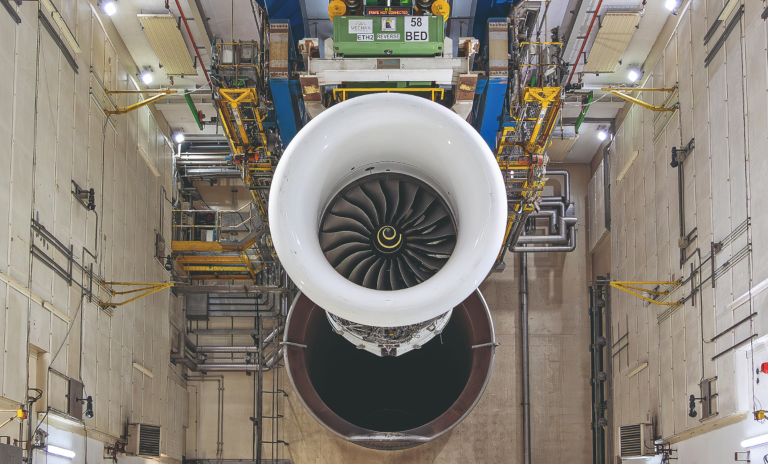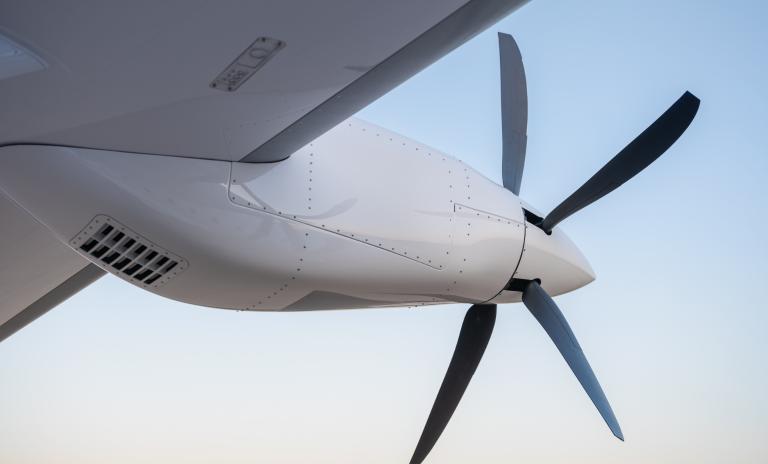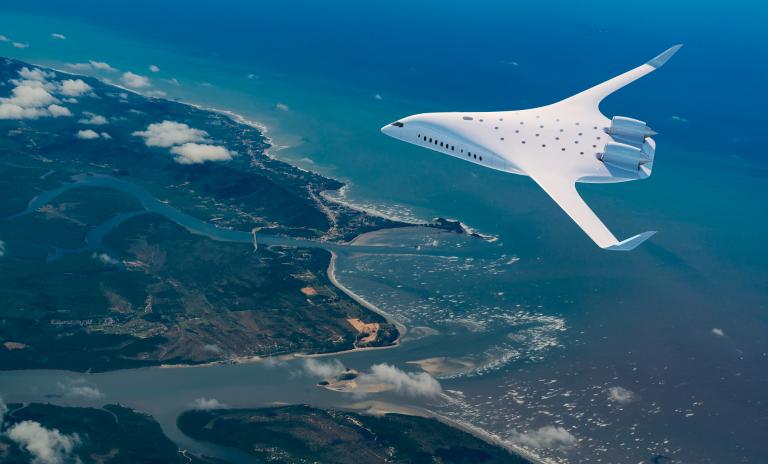Aviation's Roadmap to True Zero
Roland Berger’s Aviation´s Roadmap to True Zero sets out a sustainable approach to eliminate climate effects from air travel.
_background_none.png?v=1372397)

by Geoff Poulton
As passenger numbers continue to rise, the aviation industry is facing a crisis of sustainability. It must find a way to balance a thriving business with the technologies that will be required to reach net-zero emissions.
At the unveiling of Heart Aerospace's fully electric demonstrator aircraft in September 2024, the co-founder of the Swedish startup summed up the sustainability dilemma facing aviation. "Our industry is approaching a 30-year innovation cycle, and we have less than 25 years to decarbonize aviation," said Anders Forslund. He hopes Heart's X1 will go some way to contributing. The world's largest all-electric plane is scheduled for its first experimental flights later in 2025, with Heart hoping its commercial ES-30 model will enter service in 2028. But with a capacity for just 30 passengers and an all-electric range of 200 kilometers, it's unlikely to make much of a dent in aviation's rapidly growing carbon footprint.

Herein lies the dilemma for aviation. Global CO₂ emissions from flying are now around 2.5% of global carbon emissions. Incremental design improvements mean the latest aircraft are 15-30% more fuel-efficient than their predecessors, but the fuel itself is largely unchanged. Flying remains one of society's most carbon-intensive activities. And carbon isn't the only issue: Aviation must also address the non-CO₂ impact of flying, whose climate impacts are becoming clearer. Contrails – the white streaks of water vapor emitted by aircraft engines – seem to be the chief culprit.
$5 trillion: One estimate of the investment required to bring the aviation industry to net-zero emissions by 2050.
Source: International Council on Clean Transportation
Despite passenger demand quadrupling since 2019, flying remains a relatively niche activity: Currently just 10% of the world's population flies in most years. Yet growing middle classes and globalization mean that both passenger and freight traffic are expected to rise by almost 4% each year over the next two decades. This will result in more than 4 billion additional passenger journeys in 2043 compared with 2023, with Asia-Pacific contributing to more than half of the global net gain in passengers.
Recognizing the need, the aviation industry has committed to reaching net-zero aviation emissions by 2050. This will likely require trillions of dollars' worth of investment in new aircraft, sustainable fuels, alternative propulsion methods and updated infrastructure. In addition, as Forslund suggests, innovation in flight takes decades to implement. A new report from Cambridge University describes the industry as being "dangerously off track" in its sustainability efforts. Nevertheless, Steven Barrett, professor of engineering at Cambridge University and former head of aeronautics at MIT, says that while there's still a "very long way to go," aviation has made considerable progress in recent years. "Most airlines now have fairly aggressive sustainability targets, which should be applauded."
But airlines alone have limited influence. The challenge comes in uniting manufacturers, policymakers, airlines and investors in overcoming the technical, infrastructural and financial hurdles. "We need three things: greater industry collaboration; strategic investment to develop and scale technologies, and supportive government policies," says Simon Talling-Smith, partner at SkiesFifty, an investment company focused on sustainability in aviation, as well as former executive vice president at British Airways and chief commercial officer at Qatar Airways.
Here, we assess the industry's progress in key sustainability-related areas and look ahead to both potential challenges and breakthroughs.
One of the most feasible means of significantly reducing aviation's carbon footprint in the near-medium term, sustainable aviation fuels (SAF) are already available. SAF can be made from a range of renewable, nonfossil fuel feedstocks such as used cooking oils, fats, plant oils, municipal, agricultural and forestry waste, reducing CO₂ emissions by approximately 80% compared with traditional jet fuel. Current regulations dictate that airlines must use a blend of standard fuel with a maximum 50% SAF, although most modern aircraft could burn 100% SAF with the right fuel modifications. In 2023, Virgin Atlantic flew a Boeing 787 from London to New York with fuel exclusively produced from waste fats and plant sugars. While this sounds encouraging, there are serious hurdles around supply and price. In 2024, SAF accounted for just 0.3% of aviation fuel produced. To address this, governments are beginning to change regulations. Both the UK and EU have introduced 2% SAF mandates for 2025, rising to 10% in the UK by 2030 and 6% in the EU in the same time frame.
However, SAF currently costs three to five times more than standard fuel. Barrett says there's a chance this could improve in the near to medium term. "Aviation can survive with higher fuel costs, but the fundamental issue comes with funding the infrastructure to produce SAF." Talling-Smith agrees on the need for change and says he expects the financing landscape to evolve over the next decade. "Many governments and regulatory bodies are anticipated to introduce further incentives, such as tax breaks or carbon credits, to support green initiatives, making sustainable investments more attractive and accessible."

"These are very promising long-term solutions... but to propagate a new technology through the fleet takes 30 years."
SAF may be able to drastically reduce aviation's environmental impact, but the only way to make aviation carbon-free is to use either hydrogen or battery-electric powertrains – and both represent massive engineering challenges. Batteries are currently very heavy compared with the energy they contain, making them unsuited to large aircraft or long distances. Short of a few quantum leaps in technology, small regional aircraft like Heart Aerospace's ES-30 are likely to be the limit for this method. Hydrogen, meanwhile, takes up a lot of storage space – it's why fuel tanks on space rockets are so big. Compressing it as a gas or storing it as a very cold liquid helps, but it would still deliver less energy by volume compared with traditional jet fuel. Then there's the question of how to make the hydrogen. Most hydrogen is currently made using fossil fuel; green hydrogen, produced with renewables, is expensive and rare. Both battery-electric and hydrogen propulsion would also require major changes to airport refueling infrastructure.
Which doesn't mean companies aren't trying. Airbus, the world's largest planemaker, is bullish on hydrogen. It aims to bring to market the world's first hydrogen-powered commercial aircraft by 2035. ZeroAvia, a US-UK startup, says its hydrogen-electric engines will power a 40-to-80-seater aircraft over 700 miles by 2027. "These are very promising long-term solutions, but it's not something that will really move the needle by 2050. To propagate a new technology through the fleet takes 30 years," says Steven Barrett, echoing the concerns of Heart Aerospace's Anders Forslund. Boeing Executive Vice President Chris Raymond puts it even more bluntly, writing in 2023 that it would be "arithmetically impossible to replace the world's air fleets with hydrogen-powered airplanes in time to meet the industry's 2050 target."

Lighter materials, better engines and more aerodynamic designs make today's aircraft approximately 80% more fuel-efficient than 50 years ago. As manufacturers turn their attention to the more fundamental issues of fuel and propulsion, any further improvements in airframes and combustion engines are likely to be small ones, but research is ongoing in numerous areas.
Boeing is working with NASA on what it calls a "transonic" truss-braced wing concept, which is longer and thinner than today's designs. Initial tests on the X-66 show a 9% reduction in fuel burn, which Boeing hopes to raise to 30% with other advancements in materials, propulsion and systems architecture. First demonstrator flights are scheduled for 2028. The stealthy-looking "blended wing" approach offers a more radical – and potentially effective – take on airframe design. In September 2024, European carrier easyJet announced it will partner US startup JetZero, which claims its blended wing approach can cut fuel burn in half. Meanwhile, a joint venture between General Electric and French aerospace firm Safran is working on a new open-fan engine, which could reduce fuel consumption and carbon emissions by 20%.

Most aircraft currently follow a flight path system that has been in place for decades, but harnessing the power of satellite imaging and AI can help make minor adjustments. The biggest impact of this would be in reducing contrails. It is now believed that adjusting altitude on certain flights to avoid specific regions can drastically reduce contrail formation. This will require improvements in modeling and forecasting to enable airline operations to reroute flights with minimum impact on fuel consumption and emissions. A research team including Google and American Airlines has used satellite imagery, weather data, software models and AI tools to do just this in recent test flights, reducing contrail length by 54%.
Compared with other solutions, investment here would be tiny. One recent study estimates that contrail avoidance would add just $4 to the price of a ticket from Paris to New York. Steven Barrett believes it offers the most promising and effective near-term solution to improving sustainability in aviation. "There are still some technical challenges to solve, but this appears to be the cheapest, fastest way to reduce aviation's climate impact."

![{[downloads[language].preview]}](https://www.rolandberger.com/publications/publication_image/ta45_en_cover_download_preview.jpg)
The latest edition of Think:Act prepares us for innovation in 2025 and beyond while faced with constrained resources and uncertainty across the business landscape.
